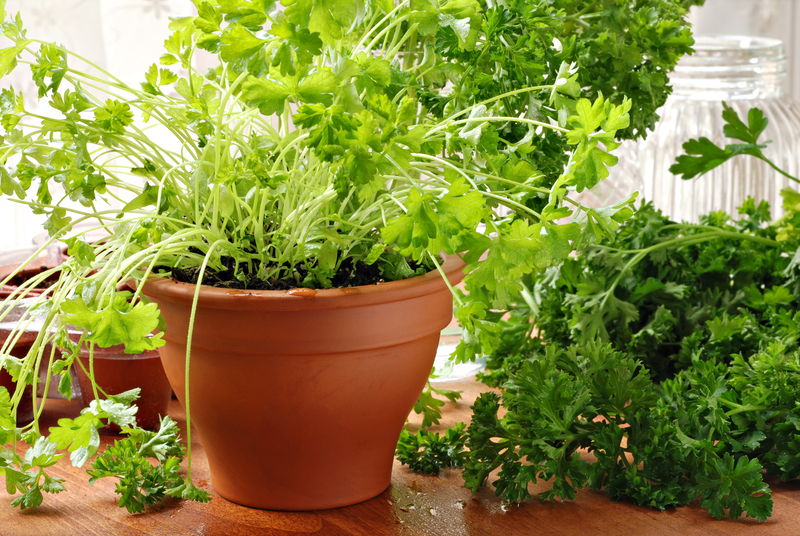Cultivate Freshness: Essential Steps to Build a Herb Garden
Posted on 26/09/2025
Cultivate Freshness: Essential Steps to Build a Herb Garden
Imagine stepping outside to snip fragrant basil leaves, cut fresh parsley, or pull a sprig of rosemary straight from your own garden. Growing a home herb garden isn't just a delight for the senses--it's a practical and rewarding project that can redefine your cooking and your connection to nature. Whether you're a beginner or a seasoned green thumb, this comprehensive guide will help you succeed in building a thriving herb garden. Explore the key steps, expert tips, and FAQs to learn how to cultivate freshness in your own space.
Why Build Your Own Herb Garden?
If you're considering embarking on a journey to grow your own herbs, here are compelling reasons why this is the perfect time to get started:
- Unparalleled Freshness: Homegrown herbs deliver superior flavor and aroma compared to store-bought ones.
- Cost Savings: Reduce your grocery bill by growing what you need at home.
- A Healthier Lifestyle: Herbs add essential nutrients and antioxidants to your meals.
- Therapeutic Benefits: Gardening reduces stress and enhances mental wellbeing.
- Environmentally Friendly: Cut down on packaging and transportation emissions.

Essential Steps to Start Your Herb Garden
1. Assess Your Space and Choose a Location
Before diving into planting, evaluate your environment. Herbs thrive in sunny, well-drained locations. Most culinary herbs require at least 6 hours of sunlight daily. Consider these options:
- Outdoors: Yard beds, raised beds, patio containers
- Indoors: Windowsills, kitchen counters, under grow lights
*Tip: If space is tight, vertical gardens or compact container arrangements can let you cultivate freshness in any urban space.*
2. Decide What Herbs to Grow
The beauty of a herb garden lies in its customization. Choose herbs based on your cooking preferences, climate, and available light. Here's a quick guide to popular herbs for beginners:
- Basil: Ideal for Italian cooking, pesto, and salads.
- Parsley: Versatile for garnishes and soups.
- Mint: Great for teas and desserts. Caution--it spreads fast!
- Rosemary: Hardy and aromatic, perfect for roasts.
- Thyme: An essential for many cuisines, easy to maintain.
- Cilantro: Key in Mexican and Asian dishes.
- Dill: Best for pickling and salads.
- Chives: Excellent in eggs, salads, and creamy dishes.
Research each herb's requirements for the best yield and flavor.
3. Choose the Right Containers or Beds
To fine-tune your herb-growing experience, select containers or garden beds that fit your space and style:
- Pots/Containers: Ensure they have good drainage. Terracotta pots work well.
- Raised Beds: Improve soil quality and drainage for outdoor gardens.
- Windowsill Planters: These maximize indoor growing potential in small spaces.
Grouping herbs with similar needs (e.g., Mediterranean herbs like rosemary, thyme, oregano) will promote healthy growth.
4. Use High-Quality Soil and Compost
The backbone of any thriving herb garden is rich, well-drained soil. Follow these guidelines:
- For containers: Use a premium potting mix, ideally enriched with organic compost.
- For garden beds: Amend the soil with well-rotted compost or aged manure to boost fertility and drainage.
Avoid heavy clay soils that retain water, as most herbs dislike "wet feet."
5. Planting Your Herbs
Depending on your climate and time of year, you can start herbs from seeds or purchase young transplants. Here's how to plant herbs for optimal freshness:
- From seeds: Follow package instructions for depth and spacing. Keep soil consistently moist but not waterlogged.
- From seedlings: Gently loosen roots and place into prepared soil, filling around the plant and watering in well.
- Spacing: Give each plant enough room to grow (often 6-12 inches apart, depending on the herb).
Label your plantings--herbs can look similar as they grow!
6. Watering and Feeding Your Herb Garden
Herbs generally prefer to dry out slightly between watering. Aim for these guidelines:
- Water thoroughly when the top inch of soil is dry.
- Ensure containers drain well--soggy roots can cause root rot.
- Feed with a diluted, balanced organic fertilizer every few weeks (but avoid over-fertilizing, which can dilute flavor).
7. Harvesting for Continuous Freshness
Regular harvesting will keep your herbs productive and flavorful. Here's what to remember:
- Snip with clean scissors or your fingers, cutting back just above a leaf node.
- For leafy herbs (basil, mint), harvest often to prevent flowering and encourage bushiness.
- Begin harvesting when plants are well-established (usually after several weeks).
- Don't remove more than a third of the plant at one time to maintain vigor.
Harvest in the morning for peak flavor and aroma!
8. Pest and Disease Management
Most kitchen herbs are naturally resistant to pests, but here's how to address common issues:
- Watch for aphids, spider mites, or whiteflies. Spray with homemade insecticidal soap as needed.
- Reduce fungal disease risk by watering at the base and spacing plants for good air flow.
- Remove any diseased or infested leaves promptly.
Organic solutions are ideal for home herb gardens to ensure your harvest remains safe and healthy.
Creative Ideas for Making Your Herb Garden Stand Out
Grow Herbs Indoors All Year Round
If you live in a colder climate or want fresh herbs year-round, indoor herb gardening is the answer. Key tips include:
- Place containers on a bright, south-facing windowsill.
- Supplement with LED grow lights in darker months.
- Choose compact varieties bred for indoor growth.
- Avoid drafts and keep temperatures stable for healthiest plants.
Vertical Herb Gardens
Maximize vertical space by mounting pots or using hanging pocket planters on fences, walls, or balconies. This attractive display helps cultivate freshness even in small apartments.
Companion Planting
Group herbs that benefit each other:
- Basil near tomatoes enhances growth and repels pests.
- Chives deter aphids when grown with carrots or lettuce.
- Mint repels ants and flies, but keep it in a separate pot to prevent spreading.
Herb Garden Maintenance: Keeping Your Garden Lush
To maintain freshness and productivity, establish a regular garden care routine:
- Water Consistently: Adjust for weather--more in heat, less in rain.
- Trim Regularly: Prevent herbs from becoming woody and keep flavors strong.
- Weed Often: Remove undesired plants to limit competition.
- Replenish Soil: Top-dress with compost every season for nutrients.
- Monitor for Pests: Check foliage frequently and address issues promptly.
With regular attention, your herb garden will stay healthy and prolific year after year.
Preserving and Using Your Homegrown Herbs
One of the best parts of cultivating your own herbs is enjoying them fresh and preserving extras when they're abundant. Try these methods:
- Freezing: Chop herbs and freeze in ice cube trays with water or oil for easy use in soups and stews.
- Drying: Tie stems in bundles and hang in a cool, dry area. Once crisp, store in airtight containers.
- Herb Vinegars and Oils: Infuse oils and vinegars for salad dressings and marinades.
Your culinary creations will benefit from the deep, complex flavors of garden-fresh herbs--right through the year.

Frequently Asked Questions About Building a Herb Garden
Can I grow herbs without a garden or yard?
Absolutely! Many herbs thrive in pots on balconies, windowsills, or under indoor grow lights--making herb gardening accessible to everyone.
Which herbs are easiest for beginners?
Basil, chives, parsley, and mint are among the easiest to cultivate. Their resilience and rapid growth make for quick culinary rewards.
Is it better to grow herbs from seeds or buy seedlings?
Both work well. Seeds offer more variety and are budget-friendly, while seedlings give you a head-start and improve success rates for beginners.
How do I keep herbs from bolting (flowering prematurely)?
Regular harvesting and pinching back tops will help herbs, particularly basil and cilantro, stay leafy and delay flowering.
Why do my herbs get leggy (tall with few leaves)?
Insufficient light is the most common culprit. Move plants to a sunnier spot or add supplemental lighting for lush, compact growth.
Conclusion: Cultivate Freshness Year-Round
Building a herb garden is one of the most rewarding and accessible ways to bring ongoing freshness to your kitchen and life. By following these essential steps for starting an herb garden, you'll enjoy superior flavors, improved wellbeing, and the simple pleasure of nurturing living plants. Whether you choose a sunny patio, a kitchen sill, or a vertical wall, the variety of ways you can cultivate freshness at home is only limited by your imagination.
Get your hands dirty, experiment with your favorite flavors, and watch your culinary possibilities grow. The journey of building a herb garden is as enjoyable as the harvest itself. Happy gardening!



